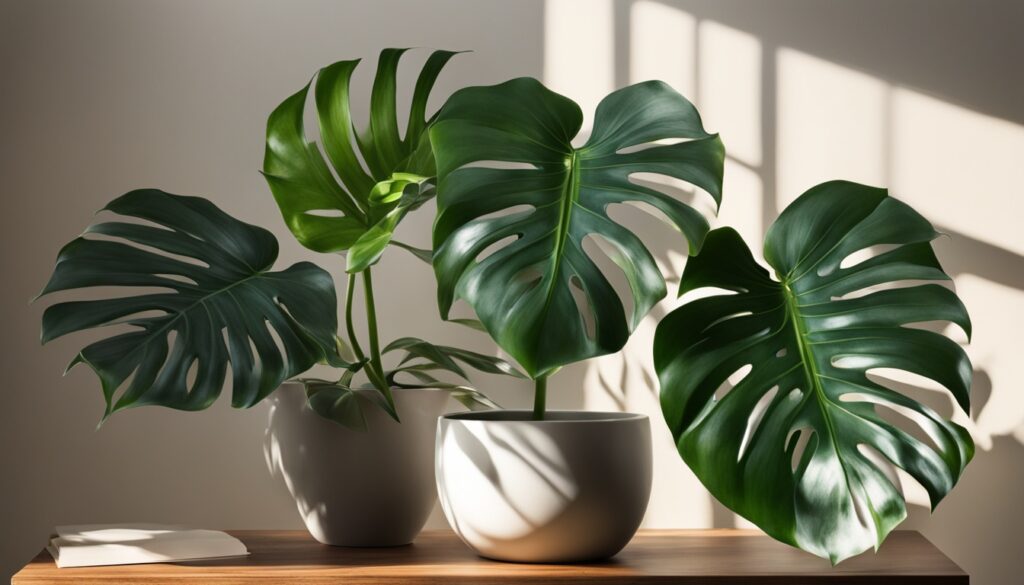Did you know the Ponytail Palm (Beaucarnea recurvata) isn’t a real palm or tree? It’s actually part of the Agave family. This plant is great for indoor and outdoor spaces because it’s easy to care for. It can grow up to 30 feet tall, making it a stunning addition to any place.
Key Takeaways
- The Ponytail Palm (Beaucarnea recurvata) is a member of the Agave family, not a true palm or tree.
- It is a drought-tolerant, slow-growing plant that requires minimal care, making it ideal for busy individuals or frequent travelers.
- Indoor Ponytail Palms typically reach up to 4 feet tall, while outdoor specimens can grow up to 30 feet in their native habitat.
- The plant features a bulb-like trunk for water storage and long, hair-like leaves resembling a ponytail.
- Ponytail Palms thrive in bright, indirect light and can tolerate a wide range of temperatures, from as low as 40°F to as high as 85°F.
To keep your Ponytail Palm (Beaucarnea recurvata) healthy, you need to know how to care for it. This guide will cover everything from light and water to soil, temperature, and pests. With the right care, your Ponytail Palm will be a beautiful addition to your space for years.
Detailed information on Ponytail Palm care
Understanding the Ponytail Palm: Not a Palm, Not a Tree
The Ponytail Palm, known scientifically as Beaucarnea recurvata, is not a palm or a tree. It’s a succulent plant from the Agave family. It comes from eastern Mexico and can grow up to 30 feet tall outside. But, indoor plants usually stay under 4 feet.
Botanical Classification and Origins
The Ponytail Palm is also known as the Elephant’s Foot or Bottle Palm. It’s part of the Beaucarnea genus. This includes other varieties like Beaucarnea guatemalensis and Beaucarnea gracilis. These plants are from a small area in Mexico and love dry, arid conditions.
Natural Habitat and Growth Patterns
In its natural home, the Beaucarnea recurvata can grow very tall. But indoors, it stays smaller. It has a bulbous trunk that holds water, helping it survive dry spells. Its long, thin leaves hang down, creating its “ponytail” look.
Unique Physical Characteristics
The Ponytail Palm grows slowly and can handle neglect well. Its special features, like the water-storing trunk and long leaves, make it stand out. These traits have made it a favorite among indoor plant lovers.
Basic Requirements for Ponytail Palm Tree Care
Ponytail palms are easy to care for and thrive on minimal attention. They love bright, indirect light and need soil that drains well. Water them sparingly, letting the soil dry out completely between waterings. This is because they store water in their trunks and are very good at surviving without much water.
These plants do well in average room temperatures and don’t need a lot of humidity. Fertilize them lightly during the growing season with a special fertilizer for cacti and succulents. With the right care, a ponytail palm can live a long time, even outliving its owners. By following simple care tips, you can enjoy a ponytail palm’s beauty in your home or office for years.
| Ponytail Palm Variety | Trunk Characteristics | Leaf Features |
|---|---|---|
| Beaucarnea recurvata | Most common type with a pronounced swollen trunk | Thinner and smoother leaves |
| Beaucarnea guatemalensis | More pronounced swollen trunk | Thinner and smoother leaves |
| Beaucarnea gracilis | Smaller, bulbous trunk | – |
Ponytail palms do best in South or West facing windows for plenty of sunlight. They can also grow well in an East facing window with morning light. However, an unobstructed Northern exposure may slow their growth because of less direct sunlight.
“Ponytail palms can go many years before needing to be repotted, with repotting required every other year at most to allow for growth in height and girth.”
To keep your ponytail palm healthy and long-lived, water it sparingly. Let the soil dry out completely between waterings, which is usually every 1-2 weeks. They prefer warm temperatures between 65-85°F and can even handle temperatures as low as 40°F. Use a well-draining potting mix or cactus/succulent-specific soil to avoid overwatering.
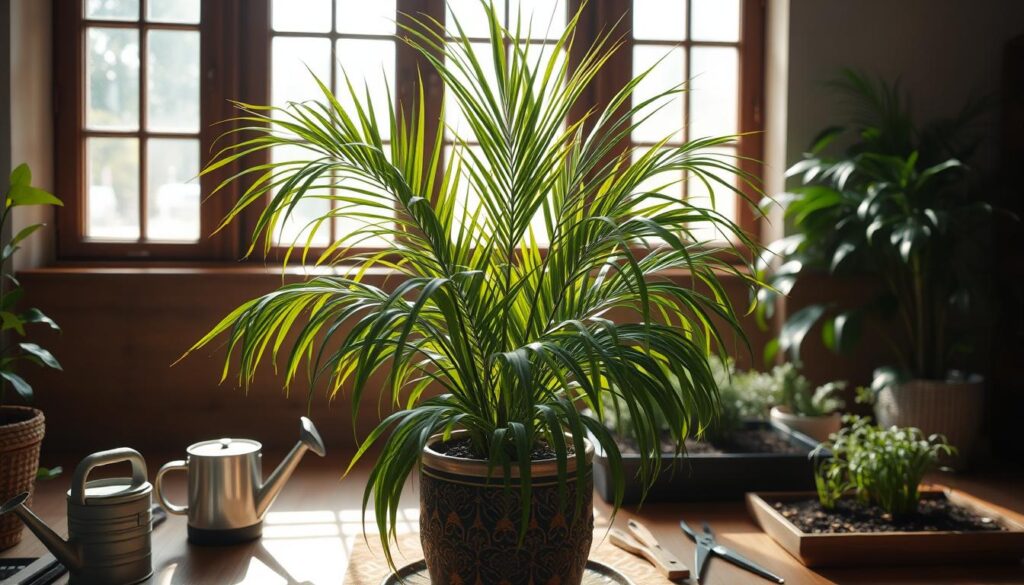
By following these low-maintenance care tips, you can enjoy a ponytail palm’s unique look for many years. Their hardiness and adaptability make them a great choice for any indoor or outdoor space.
Light Requirements and Placement
Ponytail palms are not palm trees but succulent plants. They need bright, indirect sunlight to thrive. It’s important to place them near a south-facing window for the best light.
Indoor Light Conditions
To meet the ponytail palm sunlight requirements, put it near a window with plenty of indirect sunlight. Don’t let it get too much direct sunlight, as it can burn the leaves. If your home doesn’t get enough natural light, use indoor plant lighting to help.
Outdoor Light Exposure
Outdoors, ponytail palms do well in full sun to partial shade. They can handle some shade but need enough light to grow well. In summer, make sure they get 6-8 hours of bright, indirect sunlight every day.
Seasonal Light Adjustments
Change the light your ponytail palm gets with the seasons. In winter, give it less light to help it rest. This lets it save energy for the next growing season. Don’t put it too close to cold windows to avoid damage.
| Placement | Lighting Needs | Seasonal Adjustments |
|---|---|---|
| Indoor | Bright, indirect sunlight near a south-facing window | Reduce light exposure during winter to mimic dormancy |
| Outdoor | Full sun to partial shade, at least 6-8 hours of bright, indirect light daily | Provide partial shade during scorching summer days to prevent leaf scorch |
Knowing the ponytail palm sunlight requirements helps you create the best environment. This is true whether you have it indoors or outdoors.
“Proper lighting is the foundation for a healthy, vibrant ponytail palm. Striking the right balance between brightness and indirect exposure is key to their success.”
Watering Guidelines and Schedule
Watering a ponytail palm right is key. These plants do well with less water, letting the top inch or two of soil dry out before watering again. In spring to fall, water well and make sure water drains from the pot. But, water less in winter since the plant grows slower.
Ponytail palms can hold water in their trunks, making them tough. Too much water is worse than too, as it can cause root rot. Stick to these ponytail palm watering tips to keep your plant happy and healthy.
| Watering Frequency | Soil Moisture | Conditions |
|---|---|---|
| Every 1-2 weeks | Top 1-2 inches dry | Spring through Fall |
| Reduced frequency | Dry completely | Winter |
By following these drought-tolerant plant care tips, your ponytail palm will stay healthy and bright. It’s a great choice for anyone, beginners or pros, because it’s so forgiving about water.
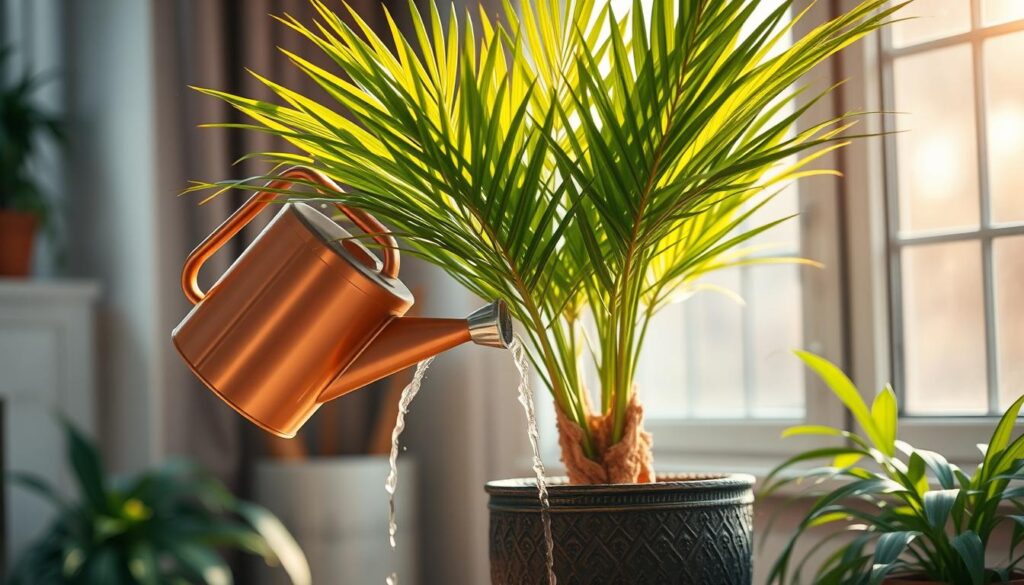
“Ponytail palms are incredibly forgiving when it comes to watering. As long as you let the soil dry out between waterings, these plants will thrive with minimal attention.”
Soil Requirements and Drainage
Caring for a ponytail palm means getting the soil right. They need a mix that drains well and is loose, like their natural home. The best soil for a ponytail palm is a mix made for cacti and succulents. It keeps the soil airy and holds just the right amount of moisture.
To make the perfect soil, mix equal parts potting soil, perlite, and coarse sand. This mix is light, drains fast, and full of nutrients. Make sure your pot has holes at the bottom to prevent water from pooling and causing root rot.
Ideal Soil Composition
Ponytail palms love a ponytail palm soil or succulent potting mix that drains well and is full of nutrients. Stay away from heavy potting mixes that hold too much water. The soil should have a pH between 6.0 and 7.5, slightly acidic to neutral.
Drainage Solutions
- Use a container with ample drainage holes at the bottom to allow excess water to escape.
- Consider planting the ponytail palm in a clay or terracotta pot, as these materials help absorb and evaporate excess moisture.
- Add a layer of gravel or crushed stones at the bottom of the pot to further improve drainage and prevent waterlogging.
- If the soil becomes compacted over time, gently loosen it around the root zone to maintain optimal drainage.
By choosing the right soil and ensuring good drainage, you can give your ponytail palm the best chance to thrive. Paying attention to soil and moisture is key for these plants to stay healthy and vibrant.
Temperature and Humidity Preferences
Keeping the right temperature and humidity is key for your ponytail palm’s health. These plants love temperatures between 65°F to 85°F (18°C to 29°C). In winter, they can handle 60°F to 80°F to rest.
Don’t let your ponytail palm get too cold. Freezing or cold drafts can harm it. Look out for signs like leaf color change, wilting, or scorching. Move the plant to a warmer spot if you see these signs.
Ponytail palms like a relative humidity of 40%-50%. If leaves curl up, it might be too dry. Use humidifiers, pebble trays, or group plants to keep humidity up.
Too much humidity can cause problems like root rot. Use fans, open windows, or dehumidifiers to keep it balanced. Check humidity with a hygrometer to keep your palm happy.
By keeping the right temperature and humidity, your ponytail palm will thrive. For more tips, check out the essential guide to ponytail palm tree.
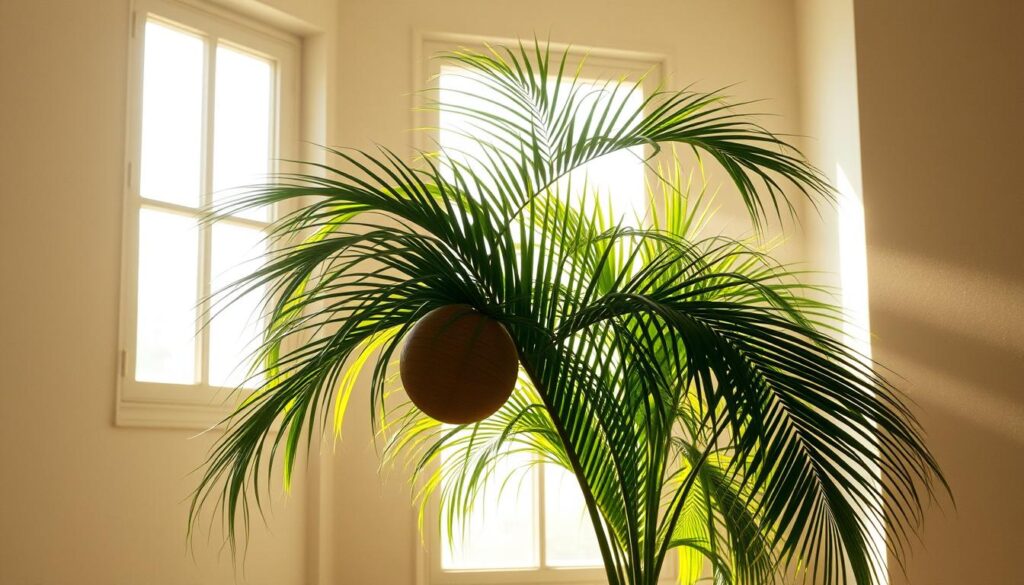
| Temperature Range | Humidity Preference |
|---|---|
| Indoor: 65°F to 85°F (18°C to 29°C) Outdoor: 60°F to 80°F (15°C to 27°C) |
40% to 50% Relative Humidity |
| Avoid temperatures below 40°F (4°C) | Excessively high humidity can lead to root rot and fungal issues |
“Proper temperature and humidity levels are crucial for the health and growth of your ponytail palm. By creating the right environment, you can ensure your plant thrives and maintains its majestic appearance.”
Fertilization Schedule and Requirements
Proper fertilization is key for your ponytail palm’s health and growth. These succulents need a balanced mix of nutrients to flourish. Use a ponytail palm fertilizer that’s water-soluble and diluted to half strength. Apply it from spring to fall when the plant is actively growing.
Types of Fertilizer
Choose a ponytail palm fertilizer or a succulent plant food with a balanced N-P-K ratio. Jack’s Classic Blossom Booster Fertilizer 10-30-20 is a good option. Slow-release fertilizers with a 13-13-13 or 14-14-14 ratio also work well for these plants.
Application Timing
- Fertilize your ponytail palm once or twice a month in spring and summer.
- Lower the frequency to once a month in winter when it’s dormant.
- Wait for a new spear to appear before fertilizing newly planted or recently repotted palms.
Too much fertilizer can harm your ponytail palm, causing brown leaf tips and stress. It’s safer to under-fertilize than to overdo it. Fixing nutrient deficiencies, like phosphorus or nitrogen, is vital for your palm’s health and blooms.
“Fertilizing your ponytail palm during the growing season is essential for its lush, vibrant growth, but it’s important to strike the right balance to avoid any potential harm.”
Repotting Your Ponytail Palm
Ponytail Palms grow slowly and need repotting every 2-3 years. Or when they outgrow their pot. When it’s time to move your ponytail palm, pick the right pot size. Use a soil mix that drains well to keep your plant healthy.
Choose a pot that’s 1-2 inches wider than your current one. Make sure it has holes for water to drain. Be gentle when handling the plant, as its leaves can cut you.
Spring is the best time to repot your ponytail palm. It’s when the plant grows the most. Use a mix of peat moss, perlite, and sand for the soil. This mix helps with drainage and aeration.
Water the plant well after repotting. But don’t fertilize for six months. Watch for signs of stress like droopy or yellow leaves. Adjust the water and light as needed.
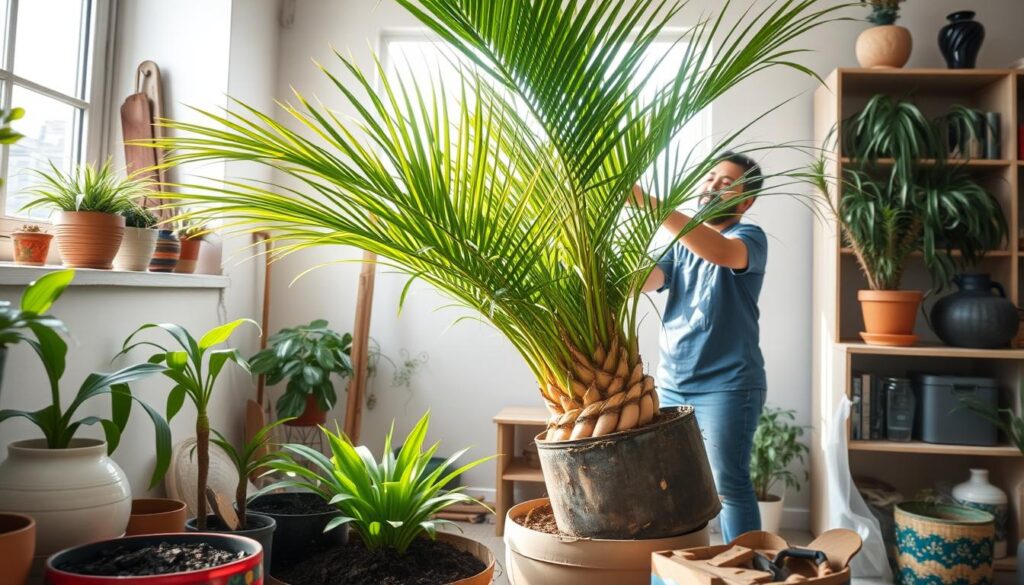
Repotting your ponytail palm is rewarding. It lets the plant grow its roots and get new nutrients. Follow these tips to keep your plant thriving and add tropical beauty to your home.
Pruning and Maintenance Tips
Keeping your [https://amzn.to/4e8UC6E] ponytail palm tree healthy and looking good is easy. These plants need very little pruning, making them perfect for both new and experienced gardeners. Focus on the key maintenance steps to keep your ponytail palm happy and thriving.
Removing Dead Leaves
One important task for a ponytail palm is to remove dead, yellowing, or damaged leaves. Use clean, sharp scissors or pruning shears to cut the leaves at the base. Be careful not to harm the healthy leaves. This simple action keeps your plant looking good and stops problems from spreading.
Shaping Techniques
While ponytail palms don’t need regular shaping, you can trim the longest leaves for a neater look. Just remember not to cut the central growing point at the top of the trunk. This could harm the plant. Also, dusting the leaves with a soft cloth helps keep them looking their best.
Pruning is not crucial for the health of a ponytail palm, but it can enhance its look. With a bit of [https://amzn.to/4e8UC6E] ponytail palm pruning and care, your indoor or outdoor space will stay lush and vibrant for many years.
| Pruning Tip | Recommendation |
|---|---|
| Leaf Removal | Snip dead, yellowing, or damaged leaves at the base using clean, sharp scissors or pruning shears |
| Shaping | Trim the longest leaves if desired, but avoid cutting the central growing point at the top of the trunk |
| Frequency | Prune as needed, typically in the spring or summer for optimal growth |
“Regular dusting of the leaves will keep the plant healthy and attractive.”
Common Pests and Diseases
Ponytail Palms are usually safe from pests and diseases. But, they can face a few common problems. Spider mites, tiny pests, can harm the plant by making webbing and spots on leaves. Mealybugs are another threat, looking like white, waxy groups on the plant.
Scale insects, small and armored, can also be a problem. Fungus gnats and thrips can harm the plant’s health too. To fight these ponytail palm pests, use insecticidal soaps or neem oil. These methods kill pests without harming the plant.
Root rot is the main disease Ponytail Palms face, caused by too much water and poor drainage. It’s important to prevent this. Make sure the soil drains well and the plant doesn’t stay wet. Plant diseases like leaf spot and powdery mildew are rare but can happen.
Keep an eye on your plant, clean it regularly, and adjust its care as needed. This way, you can keep your Ponytail Palm healthy and pest-free for many years.
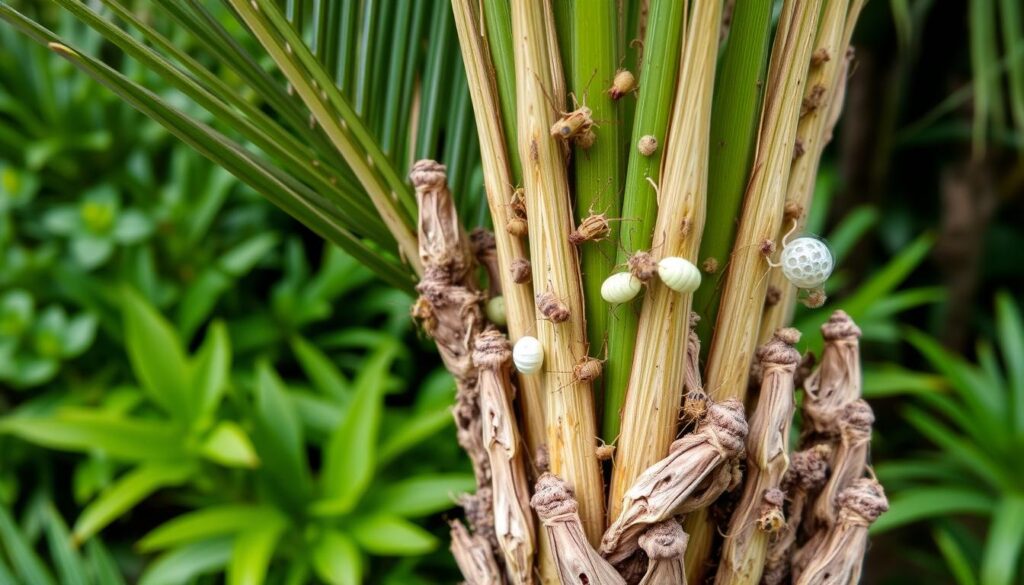
“Integrated Pest Management (IPM) is a holistic approach to pest control that emphasizes using a combination of techniques for long-term prevention and management.”
Growth Rate and Size Management
Ponytail palms, also known as Beaucarnea recurvata, grow slowly. Indoors, they can reach 4-6 feet tall. This makes them perfect for small spaces and container gardens. To keep them at a certain size, gardeners can use special methods.
Indoor Growth Expectations
Ponytail palms grow very slowly, about 1-2 feet a year. Indoors, they might reach their full size in 5-10 years. By using smaller pots, you can control their size and keep them from getting too big.
Size Control Methods
- Restrict Pot Size: Keeping the ponytail palm in a smaller container will limit its overall growth and size.
- Reduce Fertilization: Limiting the use of fertilizers, especially during the winter months, can slow the plant’s growth rate.
- Prune Selectively: Carefully trimming the longest leaves can help maintain the ponytail palm’s compact size and shape.
Knowing how fast ponytail palms grow and using these methods can help. Gardeners can enjoy their beauty without taking over indoor spaces.
Propagation Methods and Success Rates
Trying to grow a ponytail palm at home can be both rewarding and tough. The most common way is through plant offsets, or “pups,” that grow from the base of big plants. When an offset is at least 4 inches tall, you can cut it off and plant it in a mix made for succulents. Make sure the cut heals over before planting and use rooting hormone to help roots grow.
Seed propagation is not usually a good choice for indoor growers. Ponytail palm propagation success can vary a lot. Things like light, soil, and how you cut the plant all matter a lot.
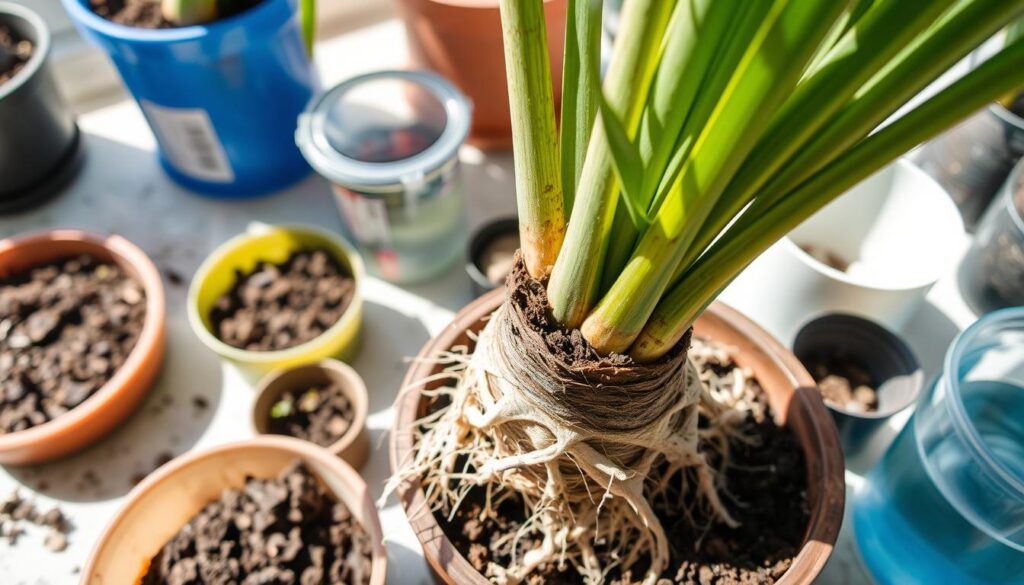
Keeping the right temperature, between 70°F to 85°F (21°C to 29°C), and moderate humidity, 40-60%, is key for healthy roots. Not enough light, bad soil, and wrong cutting methods often lead to failure.
Rot is another big problem, shown by soft stems or leaves and bad smells. Make sure cuttings heal over well and don’t water too much to avoid rot. Leaf cuttings might not always work, depending on the cutting’s health and the environment.
Genetics can affect how variegated the new plants will be. Not every cutting will look like the parent plant. By adjusting light, using good soil, and keeping tools clean, you can boost your chances of success.
Seasonal Care Adjustments
Caring for your ponytail palm changes with the seasons. In spring and summer, give it bright, indirect light and plenty of water. Also, fertilize it now and then to help it grow well.
As fall comes, start watering less and stop fertilizing. This helps your plant get ready for winter.
In winter, move your ponytail palm to a cooler spot with indirect light. Keep the temperature between 50-55°F (10-13°C). Water very little, letting the soil dry out between waterings. This saves energy and reduces stress during the cold months.
When spring comes, go back to your usual care. By changing your ponytail palm seasonal care with the seasons, your plant will do great all year, indoors or outdoors.
| Season | Light | Watering | Fertilizing |
|---|---|---|---|
| Spring/Summer | Bright, indirect | Regular | Occasional |
| Fall | Indirect | Gradually reduce | Stop |
| Winter | Indirect, cooler | Significantly reduce | None |
Adjusting your ponytail palm seasonal care helps your plant stay healthy all year. The trick is to match the light, water, and nutrients to the season and your plant’s needs.
Troubleshooting Common Issues
Caring for a ponytail palm can be rewarding, but gardeners may face challenges. Issues like leaf problems, trunk issues, and root concerns are common. Knowing how to address these problems is key to keeping your plant healthy.
Leaf Problems
Browning leaf tips often mean too much fertilizer or not enough water. Yellow leaves usually point to too much water. Fix these by adjusting your watering and making sure the plant gets the right nutrients. Proper light conditions also help keep leaves green and healthy.
Trunk Issues
A soft or squishy trunk base might mean rot, often from too much water. This can lead to fungal infections. Stop watering and let the plant dry out to fight the problem from inside.
Root Concerns
Root problems, like rot, often come from too much water. Make sure the soil drains well and the pot has good drainage. Adjust your watering and give the right nutrients to fix root issues.
| Common Issue | Possible Causes | Solutions |
|---|---|---|
| Brown Leaves |
|
|
| Yellowing Leaves |
|
|
| Soft or Squishy Trunk |
|
|
| Root Rot |
|
|
By tackling these ponytail palm problems and following good plant care troubleshooting tips, you can help your ponytail palm stay lush and vibrant.
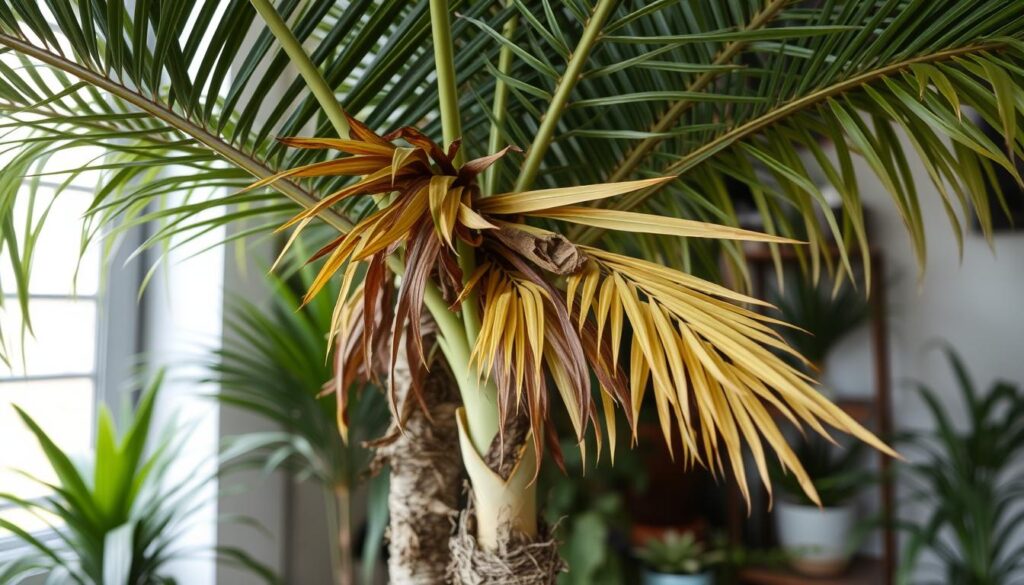
Conclusion
Ponytail Palms are special and low-maintenance houseplants that are great for any indoor spot. They have unique bulbous trunks and beautiful leaves. These plants are easy to care for, making them perfect for anyone.
By following the ponytail palm care tips in this guide, you can keep your Ponytail Palm happy and healthy. This will make your home or office look beautiful.
Ponytail Palms love dry air and bright, indirect light. They need the right soil and occasional pruning to stay healthy. These plants are great for small spaces or big containers.
Whether you’re new to indoor plants or have lots of experience, caring for a Ponytail Palm is easy and fun. This guide will help you enjoy the beauty of this plant for many years.

